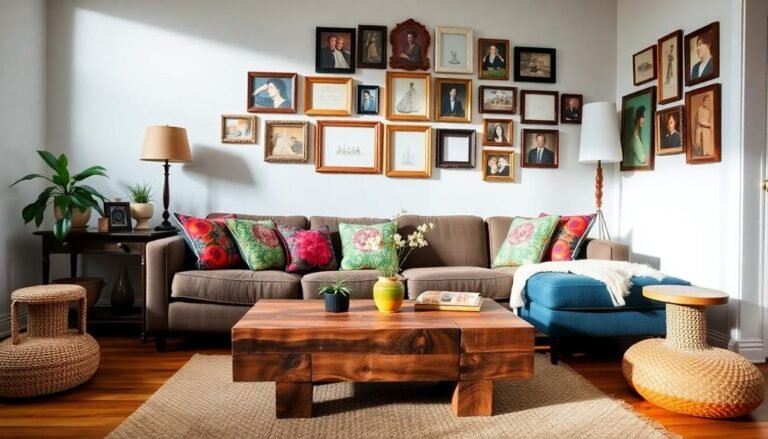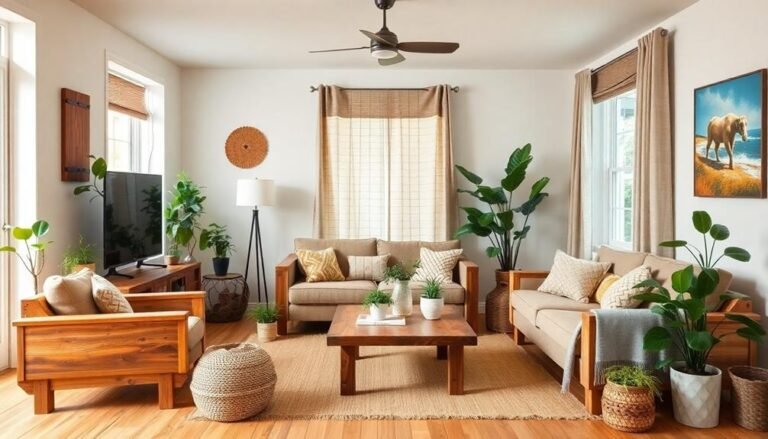To design a low-waste, eco-conscious living space, start by evaluating your environment and eliminating clutter, while prioritizing multifunctional furniture to save space. Choose sustainable materials, like reclaimed wood or organic fabrics, which support both durability and eco-friendliness. Embrace minimalism by focusing on meaningful decor that resonates with you. Opt for energy-efficient lighting, like LEDs, and incorporate indoor plants to enhance air quality and aesthetics. Implement smart storage solutions to keep your space organized. Additionally, upcycle items when possible and create a waste management plan to track and reduce waste. There's so much more you can do to enhance your sustainable lifestyle.
Assessing Your Space
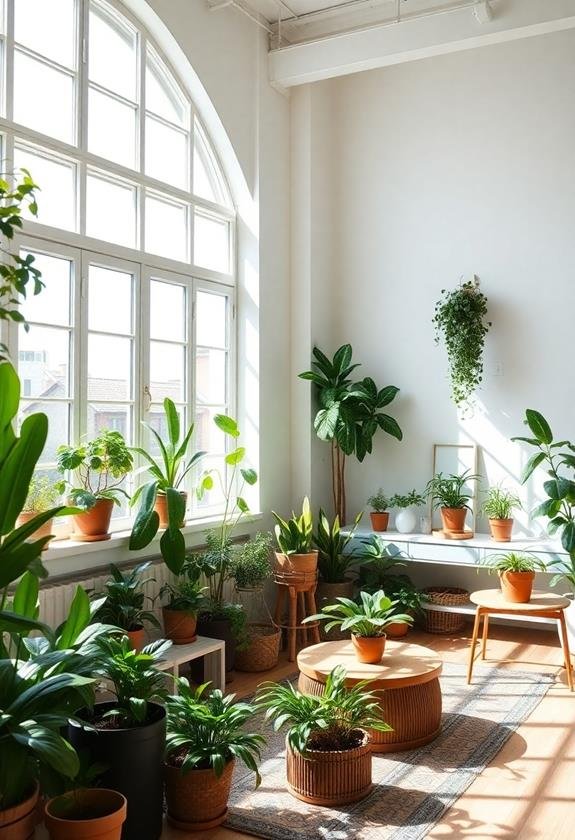
When you begin evaluating your space, take a moment to visualize how you currently use each area. Consider every room and corner; think about how you move through them daily. Are there items that clutter your space or serve no purpose? Identify these distractions, as they can hinder your ability to create a low-waste environment. Incorporating sustainable furniture options can also enhance your space while supporting eco-friendly practices.
Next, analyze how your furniture and belongings contribute to your lifestyle. Are they multifunctional or single-purpose? For instance, a sofa bed can save space and reduce the need for an extra bed, aligning with low-waste principles. You might also want to evaluate the flow of natural light and ventilation, as these elements can greatly impact your energy consumption.
As you reflect, jot down ideas for improvement. Perhaps an area could benefit from more plants, which not only enhance air quality but also bring a sense of calm. Finally, think about the overall organization; a tidy space minimizes waste and encourages mindful consumption. By taking these steps, you're not just assessing your space, but also setting the foundation for a more sustainable, low-waste living environment.
Choosing Sustainable Materials
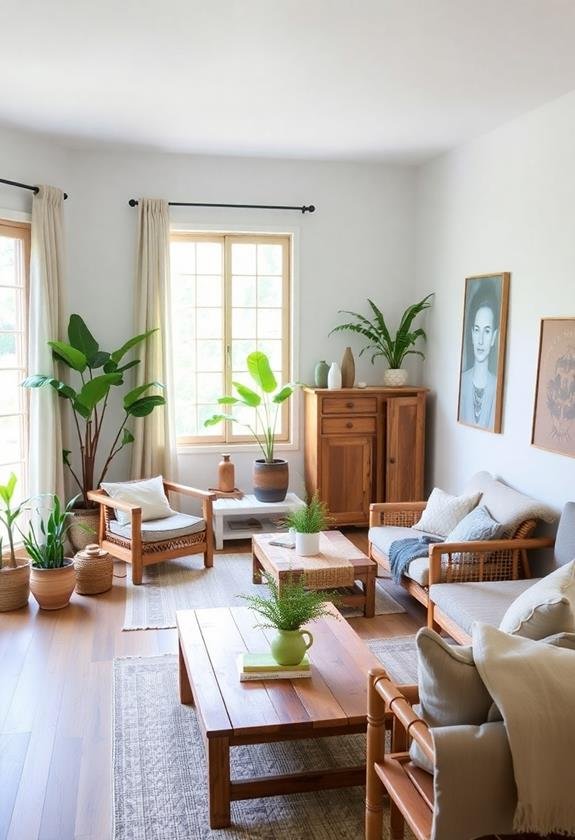
Your choice of materials plays an essential role in creating a sustainable living space. When selecting items for your home, prioritize materials that are renewable, recycled, or locally sourced. Bamboo, for example, is a fantastic choice due to its rapid growth and strength. Similarly, reclaimed wood not only adds character but also reduces the need for new lumber, minimizing deforestation. Additionally, consider incorporating compostable home products to further reduce waste and enhance sustainability in your living space, such as those found in compostable home products.
You should also consider the durability of the materials you choose. High-quality items may have a higher upfront cost, but their longevity can save you money and resources in the long run. Look for fabrics made from organic cotton, linen, or hemp, which are both eco-friendly and biodegradable when they reach the end of their life cycle.
Moreover, pay attention to the finishes and adhesives used in your space. Opt for low-VOC (volatile organic compounds) paints and finishes, as these options contribute to better indoor air quality and lower environmental impact. By thoughtfully selecting sustainable materials, you not only enhance the aesthetics of your living space but also contribute to a healthier planet, ensuring your home is a sanctuary that aligns with your values and lifestyle.
Embracing Minimalism
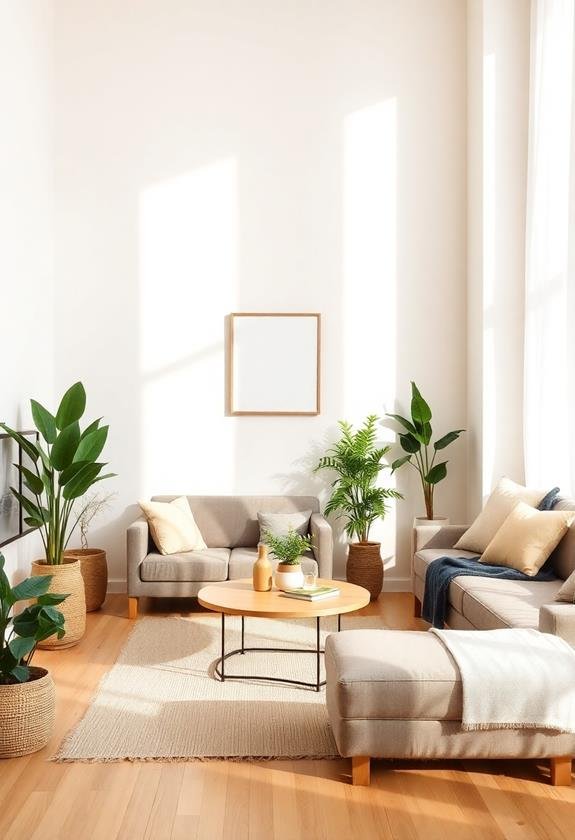
Embracing minimalism can transform your living space into a serene and purposeful environment, as it encourages you to focus on what truly matters. By consciously simplifying your belongings, you create a calming atmosphere that fosters mindfulness and reduces stress. This approach aligns beautifully with sustainable materials, as opting for responsibly sourced furnishings complements the minimalist aesthetic. Start by evaluating your possessions; ask yourself which items you genuinely need and cherish. This process lets you identify the clutter that's weighing you down.
Instead of filling your space with unnecessary decor, opt for a few meaningful pieces that resonate with you. For example, a single beautiful artwork or a cherished photograph can serve as a focal point, drawing attention without overwhelming the senses. Additionally, consider multifunctional furniture, which maximizes space and minimizes waste. A coffee table that doubles as storage not only keeps your area tidy but also enhances functionality.
Incorporating natural elements, like plants or reclaimed wood, can further enhance your minimalist aesthetic while promoting a connection to nature. Remember, minimalism isn't merely about having less; it's about making room for experiences, relationships, and a lifestyle that aligns with your values. By embracing this approach, you'll cultivate a low-waste, eco-conscious living space that truly reflects who you are.
Energy-Efficient Lighting
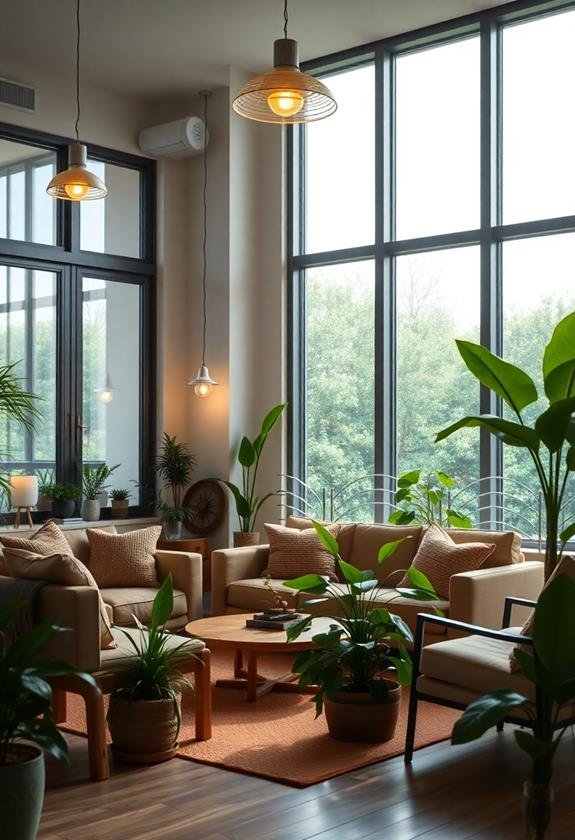
Integrating energy-efficient lighting into your living space can greatly reduce your energy consumption while enhancing the overall ambiance. You might start by replacing traditional incandescent bulbs with LED or CFL options, which use considerably less energy and last much longer. This simple switch can lead to noticeable savings on your electricity bill, making it a smart choice for both your wallet and the planet.
Consider using dimmable lights in various rooms, allowing you to adjust the brightness according to your needs. This not only creates the perfect mood for every occasion but also helps you save energy when full brightness isn't necessary. Additionally, installing motion sensors in areas like hallways or bathrooms guarantees lights only activate when someone is present, reducing waste.
Natural light is another fantastic resource—maximize it by using sheer curtains or strategically placing mirrors to reflect sunlight. You'll brighten your space without relying solely on artificial sources. By thoughtfully selecting energy-efficient lighting and embracing natural illumination, you can create a cozy, inviting environment while contributing to a more sustainable lifestyle. Each small change adds up, making your home both stylish and eco-conscious.
Smart Storage Solutions
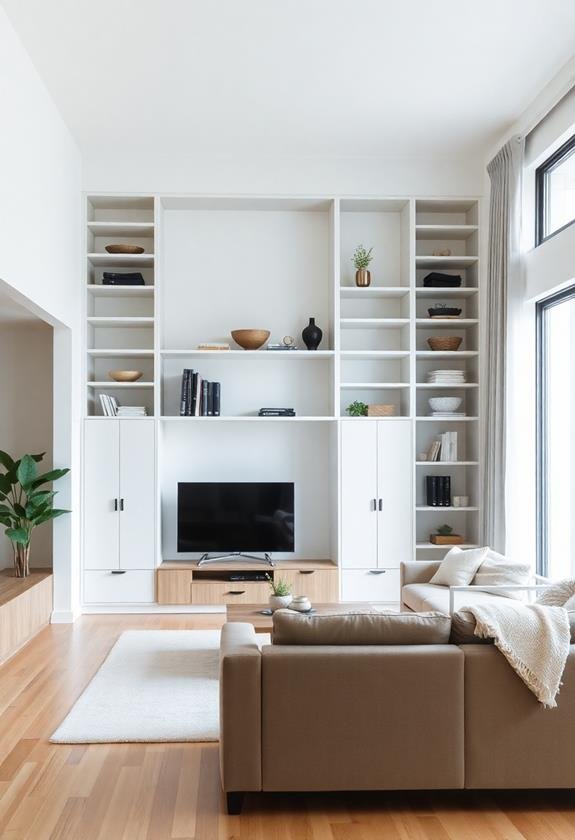
While maximizing space in a low-waste living area, smart storage solutions play an essential role in maintaining organization and reducing clutter. By being strategic about how you store your belongings, you can create a more functional and eco-friendly environment. Here are four effective storage ideas to contemplate:
- Multi-Functional Furniture: Use pieces like ottomans or coffee tables with hidden compartments. They not only save space but also reduce the need for additional furniture.
- Vertical Storage: Install shelves or wall-mounted racks to take advantage of vertical space. This keeps items off the floor and creates a visually appealing display.
- Baskets and Bins: Use natural fiber baskets or bins for organizing smaller items. They're durable, reusable, and can add a touch of style to your space.
- Decluttering Regularly: Commit to a routine of evaluating your belongings and removing what you no longer need. This helps maintain a low-waste lifestyle and prevents overcrowding.
Incorporating Indoor Plants
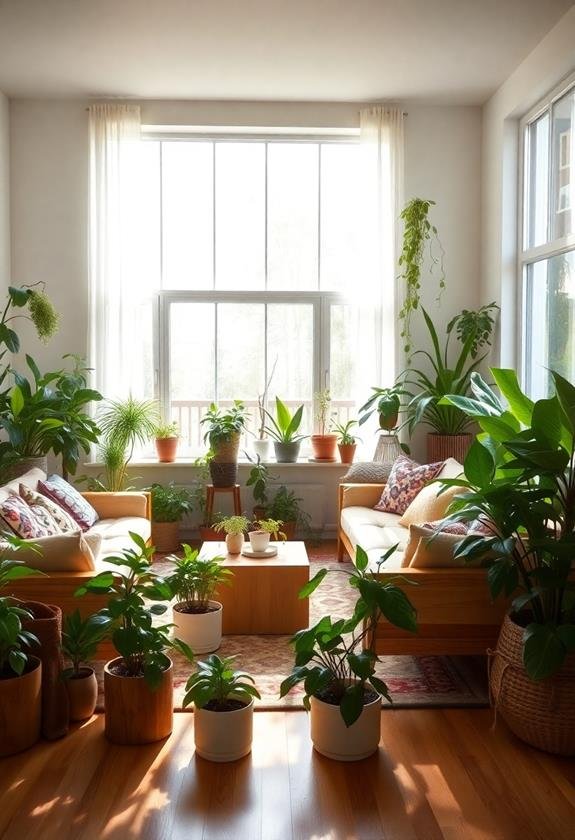
Incorporating indoor plants into your low-waste living space not only enhances aesthetics but also improves air quality and boosts your mood. Plants act as natural air filters, absorbing toxins and releasing oxygen, which is essential for a healthy environment. You can choose a variety of indoor plants, such as snake plants or pothos, that require minimal care and thrive in various lighting conditions.
To get started, think about the space you have available. Placing plants on windowsills, shelves, or hanging them from the ceiling can create an inviting atmosphere. If you're short on space, consider smaller plants or even vertical gardens, which can maximize your greenery without taking up too much room.
Additionally, caring for plants can be a rewarding experience. You'll learn about their individual needs, and nurturing them can provide a sense of accomplishment. Plus, plants can serve as a natural humidifier, making your living area more comfortable, especially in dry climates.
Upcycling and Repurposing

Creating a low-waste living space goes beyond just adding plants; it also involves finding new uses for items you already own. Upcycling and repurposing not only reduces waste but also sparks creativity. You can transform everyday items into something functional and stylish. Here's how you can start:
- Glass Jars: Use empty jars for storage or as unique vases. They add character to your space while keeping clutter at bay.
- Old T-Shirts: Turn worn-out tees into reusable shopping bags or cleaning rags. This way, you're reducing plastic usage while giving your clothes a second life.
- Furniture Makeovers: Give old furniture a new lease on life with a fresh coat of paint or by reupholstering. This not only saves money but also allows you to customize your space.
- Wooden Pallets: Repurpose wooden pallets into shelves or garden planters. They're versatile and can add rustic charm to any room.
Creating a Waste Management Plan
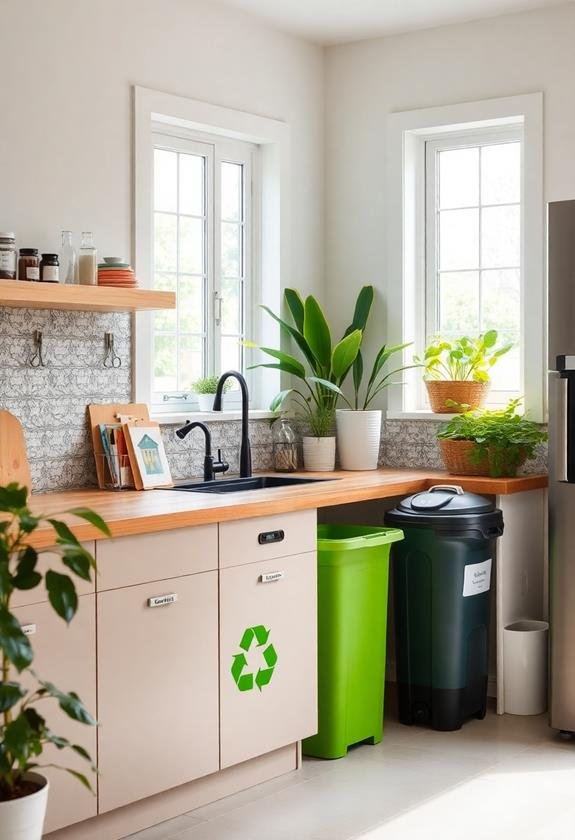
Establishing a waste management plan is essential for maintaining a low-waste living space. Start by evaluating your current waste habits; track what you throw away for a week. This gives you insight into the types of waste you generate, helping you identify areas for improvement. Once you understand your waste patterns, set clear goals. Aim to reduce, reuse, and recycle as much as possible.
Next, designate specific containers for different types of waste: recyclables, compost, and trash. Label them clearly, making it easy for everyone in your household to sort waste correctly. Consider implementing a compost system for organic waste, which can enrich your garden and reduce landfill contributions.
You might also want to schedule regular waste audits, revisiting your plan every few months to guarantee it remains effective. Engage family members in discussions about waste reduction strategies, fostering a collective commitment to eco-conscious living. Finally, educate yourself on local recycling programs and guidelines to guarantee compliance and maximize recycling efforts. By actively managing your waste, you'll not only create a more sustainable living space but also inspire others to adopt similar eco-friendly practices.
Frequently Asked Questions
What Are the Benefits of a Low-Waste Lifestyle?
Embracing a low-waste lifestyle contrasts the ease of convenience with the satisfaction of sustainability. You'll find that reducing waste not only cuts costs but also fosters a sense of community, as you connect with like-minded individuals. By choosing reusable products, you contribute to a healthier planet, enhancing your mental well-being. Plus, the creativity involved in upcycling can be rewarding, turning trash into treasure, and making your space uniquely yours.
How Can I Encourage Others to Adopt Eco-Conscious Habits?
To encourage others to adopt eco-conscious habits, lead by example. Share your experiences and the positive impacts of your choices, like reducing waste or using sustainable products. Organize community clean-ups or workshops to engage people actively. Provide practical tips on recycling, composting, or energy conservation. You can also create a friendly competition among friends to see who can adopt the most eco-friendly habit. This fun approach makes sustainability appealing and achievable for everyone.
What Are Some Common Misconceptions About Sustainable Living?
You might think sustainable living is all about strict rules or expensive choices, but that's not true. Many believe you need to sacrifice comfort or style, yet eco-friendly options can be stylish and affordable. People often assume recycling is enough, overlooking the importance of reducing and reusing. Additionally, some think it's only for the wealthy, ignoring that small, mindful changes can make a significant impact, regardless of your budget. Sustainable living is accessible for everyone.
How Do I Maintain a Low-Waste Home Long-Term?
How can you keep your home low-waste for the long haul? Start by establishing consistent habits, like composting and recycling, which reduce waste considerably. You'll also want to invest in durable, multi-purpose items instead of single-use products. Regularly assess your belongings; decluttering helps you avoid unnecessary purchases. Finally, educate yourself about sustainable brands and practices, so every decision aligns with your low-waste goals, creating a more eco-friendly lifestyle you can maintain.
Can Eco-Conscious Design Be Stylish and Functional?
Absolutely, eco-conscious design can be both stylish and functional. You can choose sustainable materials like bamboo or reclaimed wood, which not only look great but also reduce environmental impact. Incorporating multi-functional furniture, such as a sofa bed or a coffee table with storage, maximizes space while being practical. By blending aesthetics with sustainability, you'll create a living area that reflects your values, enhances comfort, and showcases your unique style without compromising on function.


